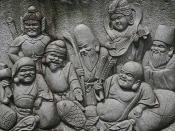This Holy Sonnet has been constructed to conform to the Italian or Petrarchan structure of a sonnet, with two quatrains and a sestet with an ABBA-ABBA-CDCDDD rhyme scheme. The basic rhythm is iambic pentameter, although certain lines, such as the second one, may be seen as spondaic. "Batter my heart" is an imperative to God by the narrator and it conveys separate yet related concepts and emotions in three 'partitions' that are created as a result of the sonnets tightly structured form.
The first quatrain represents the speaker as an individual pleading for God to "batter" his "heart" (Line 1) and enter his life - breaking, blowing and burning him so that the speaker may arise like a phoenix from the flames, cleansed and chaste.
In the second quatrain, the speaker compares himself to an "usurped town" (Line 5) in which he has no power to allow God passage. He feels feeble as the reader is given the impression that matters are out of his hands as God's appointed official, "your viceroy in me"(Line 7), appears to have failed in his duties "and proves weak or untrue"(Line 8).
The sestet deals with lust and the knot of marriage. The speaker loves God on a spiritual and mental level, but cannot achieve the physical as he is "betrothed" to His "enemy" (Line 10). God is then asked to "enthrall" (Line 13) him like a slave reduced to subjection and then "ravish" (Line 14) him. Ravish is derived from the Latin rapere, which loosely translated means to seize by force, and we are presented with an image of rape. However, in pietistic tradition, a religious person's love of God was often described in romantic terms with much emotive and even vulgar language - a more physical description of love was acceptable as...


